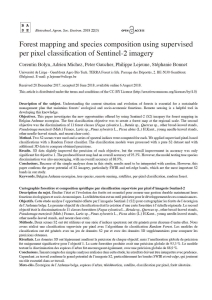Bolyn C., Michez A., Gaucher P., Lejeune P., Bonnet S.
per pixel classification of Sentinel-2 imagery. Biotechnol. Agron. Soc. Environ. 22(3) 16p.
Description of the subject.Understanding the current situation and evolution of forests is essential for a sustainable management plan that maintains forests’ ecological and socio-economic functions. Remote sensing is a helpful tool in developing this knowledge.
Objectives. This paper investigates the new opportunities offered by using Sentinel-2 (S2) imagery for forest mapping in Belgian Ardenne ecoregion. The first classification objective was to create a forest map at the regional scale. The second objective was the discrimination of 11 forest classes (Fagus sylvatica L., Betula sp., Quercus sp., other broad-leaved stands, Pseudotsuga menziesii (Mirb.) Franco, Larix sp., Pinus sylvestris L., Picea abies (L.) H.Karst., young needle-leaved stands, other needle-leaved stands, and recent clear-cuts).
Method. Two S2 scenes were used and a series of spectral indices were computed for each. We applied supervised pixel based classifications with a Random Forest classifier. The classification models were processed with a pure S2 dataset and with additional 3D data to compare obtained precisions.
Results. 3D data slightly improved the precision of each objective, but the overall improvement in accuracy was only significant for objective 1. The produced forest map had an overall accuracy of 93.3%. However, the model testing tree species discrimination was also encouraging, with an overall accuracy of 88.9%.
Conclusions. Because of the simple analyses done in this study, results need to be interpreted with caution. However, this paper confirms the great potential of S2 imagery, particularly SWIR and red-edge bands, which are the most important S2 bands in our study.
Consultez la notice complète de l’article sur ORBi

